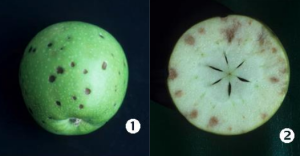IPDM Quick Facts
• Bitter pit is a physiological disorder of apples which occurs when insufficient calcium is present in fruit.
• Symptoms of bitter pit include dark sunken pits on the surface of the fruit (see image 1 below) and corky brown tissue (see image 2 below) which can be confused with feeding damage from stink bugs and Harlequin bug
• Poor weather or choice of pesticides applied during bloom may impact on bee activity and result in low crop loads due to reduced pollination
• Lightly cropped trees are more prone to this problem

Photo 1: Bitter pit on surface; 2. bitter pit in tissue (Photo: Australian Apple and Pear IPDM manual)
Bitter pit is a disorder often associated with larger fruit, but a better understanding of the causes of calcium deficiency and how it relates to other factors in the orchard will help growers to treat the problem. Fruit calcium levels can be influenced by many things, but the major cause of bitter pit is a high leaf to fruit ratio. Lightly cropped trees are more prone to this problem.
Light cropping and bitter pit: causes
Poor pollination: Inappropriate pollinators or lack of bee activity due to rainy, windy or cold weather during bloom or use of insecticides which are toxic to bees. The number of seeds in fruit provides a rough index to the level of pollination; where fruit have only a small number of seeds beware of bitter pit.
Tree age: Young trees tend to have greater vigour and therefore a higher leaf to fruit ratio.
Excessive vigour: Over fertilisation, over watering and excessively hard pruning promote foliar growth at the expense of fruit production which boosts the leaf to fruit ratio.
Over-thinning: Over-thinning can occur as a result of poor management or naturally, because of hail, late frosts etc.
Other factors causing bitter pit
Variety and rootstock: Late in the season as fruit finalises its maturation it loses its connection to the xylem. The xylem is the tube which passes calcium from the roots to the fruits. Varieties which lose this connection earlier, accumulate less calcium and are prone to bitter pit. These varieties include Braeburn, Granny Smith, Gravenstein, Jonathon and Golden Delicious. Varieties less likely to suffer from bitter pit for this reason include Red Delicious. Incompatibility between scions and rootstocks can also limit xylem flow and consequently affect calcium uptake.
Poor uptake of calcium by the roots: Anything which affects root health and function can be the primary cause of bitter pit. This includes dry or waterlogged soil, low soil calcium, a low calcium-to magnesium ratio, a large amount of potassium fertiliser, heavy weed or grass growth, or competition between tree roots in a high-density planting. Poor root function can also be caused by salinity, acidic soil, inadequate phosphorous, compaction, low oxygen, cold conditions, root disease, replant or nematodes.
Preventative management
A soil analysis should be carried out on new blocks prior to planting and suitable varieties and variety/rootstock combinations planted. Where established blocks have been affected by bitter pit in
previous seasons growers should determine the underlying cause (e.g. poor pollination etc.) and treat it appropriately. Up to six foliar calcium applications per season may be required. Late season foliar calcium applications are particularly important because late in the season there is reduced transport of nutrients from the soil to the fruit and foliar applications are the most successful way of boosting calcium.
More Information
Warner, G. 2008. Bitter pit causes are complex. Good Fruit Grower. April 15, 2008. †
Acknowledgements
This article is republished from the Australian Apple and Pear IPDM Manual (2019 edition, HortInnovation), prepared by David Williams1 and Oscar Villalta1 with contributions by Stephen Quarrell2, Kevin Dodds3, Paul James4, Alison Mathews5 and Stewart Learmonth5
1 Agriculture Victoria; 2 TIA; 3 NSW DPI; 4 Lenswood Cooperative, 5 DPIRD WA
